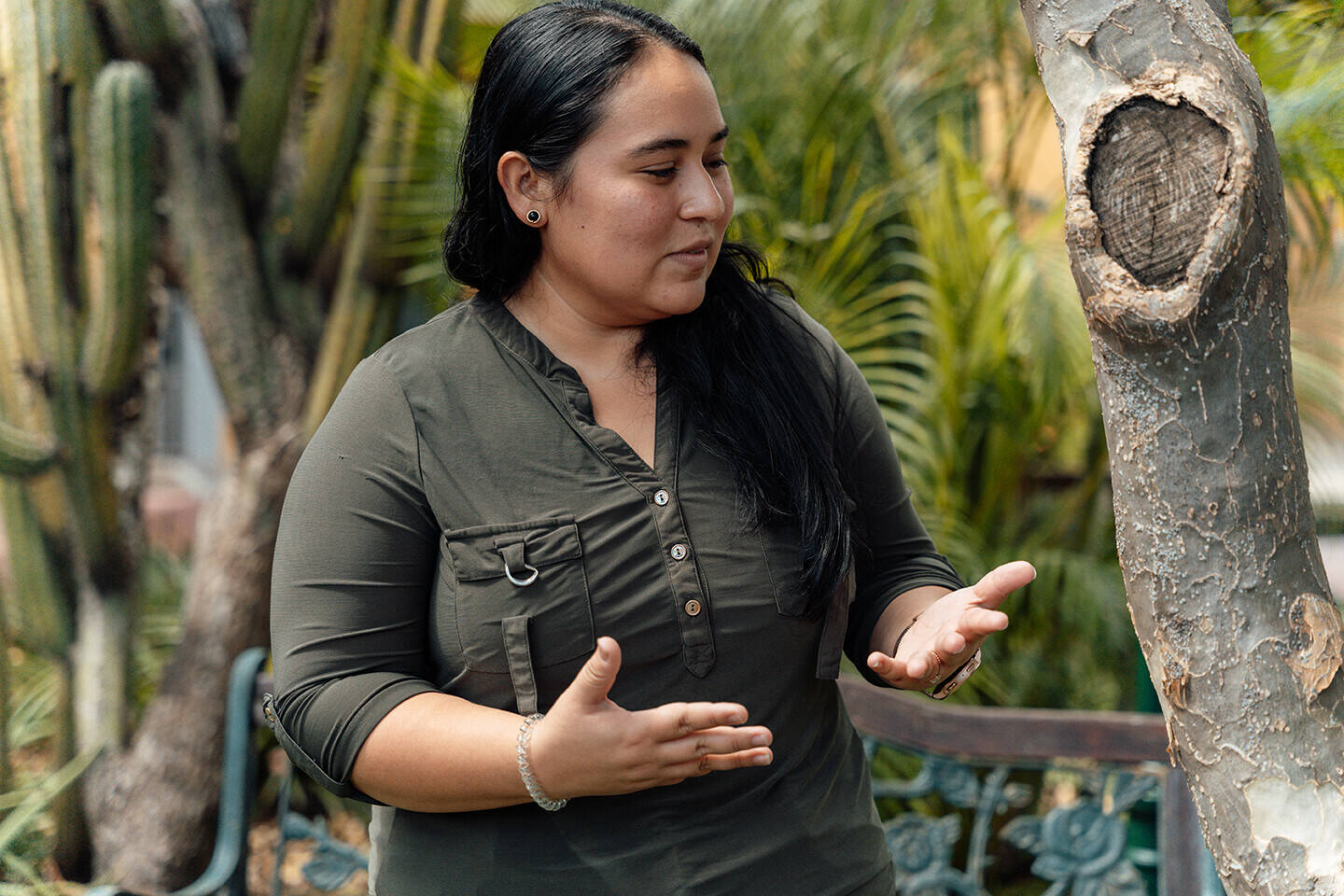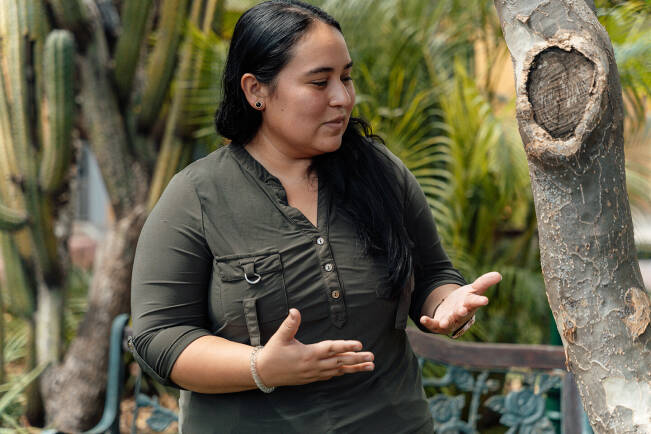English
Let’s address difficult topics such as sex, gender and sexual orientation, says Cinthia Quant. “It all starts with respecting the diverse nature of people, because no one is the same.”

See also the Dutch Augeo magazine about the relationship between gender and domestic violence, which was recently published. With experience stories, do’s and don’ts, background articles and an animation.

Change
Fear or respect
When people step out of the box they have been put in, they run the risk of rejection and violence
It is not a matter of blaming someone else. It starts with the person staring back at you in the mirror

6 min
Psychologist and coordinator at HIAS Aruba
Cinthia Quant
Background
Letting go of cultural norms and stereotypes paves the way for assertive children
Next article
Share this page
Table of contents
Scroll down
Not all countries define GBV as broadly as UNHCR. Quant considers it as an umbrella term for harmful acts against a person, because of who that person is. “Some countries limit GBV to domestic violence, other countries, like Spain, define GBV as violence against a woman within or after a relationship,” Quant says. “It is important for a country to define GBV, which does have an inter-relational violence component. To me it is violence based on gender norms and stereotypes associated to the sex of a person.”
Sex, gender and sexual orientation are words that rile up a lot of emotion, and often that includes anger, Quant explains. Sex refers to the biological attributes associated with the physical and physiological features of a person, gender is a social construct that refers to norms, behaviours and roles associated with being born with a specific sex, and sexual orientation is to whom a person is attracted to. According to Quant, these terms are regularly conflated. This makes creating a GBV victim profile more difficult. “Some individuals, like people with legal status or a large network, have more protection due to the measures built up in a system, in laws, all designed to reduce the risk of violence and abuse. However, even those with top, high earning professions can experience violence, that can vary from insults to physical altercation.”
Change also takes time and effort. It requires opportunities, access to information, and safe spaces for dialogue, without the fear of repercussion. “Schools are important. The starting point is respect for the individual, so the child can grow to be a respectful, confident and empathic human being. It means respecting the diverse nature of people, because no one is the same. This is the basis for the theme of gender and has nothing to do with sexuality. Once there is respect for a child as a human, everything else will fall into place.” The same is the case for parents. They too need safe spaces in order to make discussing mental health the norm and learn how to regulate emotions, in order to be role models for their children so they become high functioning individuals.
In order to achieve a healthy society that is based on respect, cultural structures need to develop, on all levels, including the legal system. For children to become more assertive, parents need to be open to adapting and acceptance. This can happen through training at work. Employers can create safe spaces for their employees, open up the conversations on mental health, allow people to take mental breathers, and understand “not every day is a good day,” Quant says. “Of course, this has to come with accountability, but the discussion about mental health has to be front and centre. Just like children spend a lot of time at school, their parents spend a lot of time at work and employers can be flexible and provide time and space for these parents to attend interactive workshops and courses to help them learn to cope with their stresses, emotions and be better functioning parents and employees. They need to learn how to become functional human beings.” But in order to compel each party to participate, legal structures need to be in place, including messaging in and through the media. “Interventions have to be monitored to ensure accountability, otherwise they don’t work,” is the conclusion of Cinthia Quant.
The way to prevent the cycle of violence is to decode a culture that has been in existence for generations. “In an adult-centred society, the adult knows and determines everything and a child has no voice. I, for instance, created issues for my parents. I would not take no for an answer from my father and always insisted that he explained his decisions to me. At first, my dad thought I was being disrespectful. But even as a child, I was aware of my right to receive sound reasoning for a decision made on my behalf.” Quant understands that disciplining a child is not easy, and resorting to violence is easier and faster. “It is much quicker to correct using a slap, for instance, when a child sticks a finger in an electrical socket. But that correction is based on a relationship of fear.
If the parent or adult takes the time to explain to the child why sticking a finger in a socket is dangerous, that child will understand, and will avoid doing it. This is a change of behaviour based on respect. Many parents say proudly their children respect them. My question is, ‘Is it respect or fear’? Children who truly understand and respect their parents and are respected in return have a greater chance of avoiding harmful behaviour, compared to those who act out of fear.”
According to Quant, it is necessary to change the gender stereotypes used in Aruba that leads to violence, particularly when children don’t meet the expectations of families and societies. “A boy playing with a barbie doll can easily become a victim of violence if the family sees it as unacceptable. Or girls can become subjected to violence when they protest their task to do house chores whereas their brothers don’t have to. Children are labelled with certain expectations just because of their sex and when they do not fit with the stereotype, they are exposed to violence. When people step out of the box they have been put in, they run the risk of rejection and violence.” Often, primary caretakers are responsible for violence, those who are supposed to be the ones who love the children the most. “This normalises associating love with violence.”
Dynamics of violence toward children go beyond parents, as they too are trapped in a system of stereotypes and norms of gender. Quant recalls an experiment where one baby was first dressed in pink, then in blue outfits and how adults then reacted differently to the child. The messaging toward the baby dressed in pink reinforced the stereotypical desires and wishes for girls, where beauty and sweetness were emphasised, while the same baby dressed in blue was told to be strong and brave. “I always ask people during the training sessions to imagine a nurse or a firefighter. The first image that comes to mind indicates how deep stereotypes are ingrained in our subconsciousness.” Generally, boys are expected to show fewer emotions and are not taught how to handle them. “And then as adults, everyone is surprised that some men cannot handle their feelings. It is not biological. This is why we see that not all men have problems dealing with their emotions.”
In the social construct of Aruba, we look at a society where the man is the head of family, followed by women, children and nature or the environment as last. Quant: “Statistics show most violence is conducted by men, usually on women but also on children who are seen as inferior on the cultural totem pole. Children are seen as property, as inferior, with no right to voice their opinions. Of course, adults need to guide children, but parental rights come with responsibility, and that entails also teaching children how to manage power.” Even children are taught some are less than others. “This is generationally ingrained. It means the culture needs to change. It is not a matter of blaming someone else. It starts with the person staring back at you in the mirror.”
HIAS stands for Hebrew Immigrant Aid Society, the oldest refugee organisation in the world founded in 1881 in New York, opened an office in Aruba in 2019 to help with the Venezuelan response on the island. One of the major challenges facing vulnerable populations, including refugees, is the lack of respect for human rights and the exposure to violence. Their irregular status makes them more vulnerable to violence as they are less likely to seek help due to the fear of deportation.
Quant, upon completing her education, came back to Aruba and worked for a year as a psycho- therapist in violence cases. At HIAS she started out as a GBV officer, with a role closer to that of a social worker, responsible for making action plans for survivors, as well as coaching them. Now she leads a team of five that is responsible for support groups, advocacy, workshops, case management to help survivors and providing trainings on gender-based violence prevention and response. This concept, according to the United Nations Refugee Agency (UNHCR), refers to harmful acts directed at an individual based on their gender and is rooted in gender inequality, the abuse of power and harmful norms. Gender-based violence can include sexual, physical, mental and economic harm inflicted in public or in private. It also includes threats of violence, coercion and manipulation.
Children have the same rights as any adult and deserve respect. Yet, patriarchy and adult-centrism have proven to be detrimental for equity and equality, and are part of a social-cultural construct that needs to be dismantled in a holistic manner. Sex, gender and sexual orientation, difficult topics to discuss in Aruba, therefore need to be included in that integrated approach.
Cinthia Quant (29) has a sound basis from which to make these statements. She is in charge of coordinating and organising services to combat Gender Base Violence (GBV) at HIAS Aruba.
Different interpretations
Expectations
Feelings
Violence meter
Immigrant aid

Illustration by Studio Fonq

Share this page
Table of contents
English
Next article
Change also takes time and effort. It requires opportunities, access to information, and safe spaces for dialogue, without the fear of repercussion. “Schools are important. The starting point is respect for the individual, so the child can grow to be a respectful, confident and empathic human being. It means respecting the diverse nature of people, because no one is the same. This is the basis for the theme of gender and has nothing to do with sexuality. Once there is respect for a child as a human, everything else will fall into place.” The same is the case for parents. They too need safe spaces in order to make discussing mental health the norm and learn how to regulate emotions, in order to be role models for their children so they become high functioning individuals.
In order to achieve a healthy society that is based on respect, cultural structures need to develop, on all levels, including the legal system. For children to become more assertive, parents need to be open to adapting and acceptance. This can happen through training at work. Employers can create safe spaces for their employees, open up the conversations on mental health, allow people to take mental breathers, and understand “not every day is a good day,” Quant says. “Of course, this has to come with accountability, but the discussion about mental health has to be front and centre. Just like children spend a lot of time at school, their parents spend a lot of time at work and employers can be flexible and provide time and space for these parents to attend interactive workshops and courses to help them learn to cope with their stresses, emotions and be better functioning parents and employees. They need to learn how to become functional human beings.” But in order to compel each party to participate, legal structures need to be in place, including messaging in and through the media. “Interventions have to be monitored to ensure accountability, otherwise they don’t work,” is the conclusion of Cinthia Quant.
Change
The way to prevent the cycle of violence is to decode a culture that has been in existence for generations. “In an adult-centred society, the adult knows and determines everything and a child has no voice. I, for instance, created issues for my parents. I would not take no for an answer from my father and always insisted that he explained his decisions to me. At first, my dad thought I was being disrespectful. But even as a child, I was aware of my right to receive sound reasoning for a decision made on my behalf.” Quant understands that disciplining a child is not easy, and resorting to violence is easier and faster. “It is much quicker to correct using a slap, for instance, when a child sticks a finger in an electrical socket. But that correction is based on a relationship of fear.
If the parent or adult takes the time to explain to the child why sticking a finger in a socket is dangerous, that child will understand, and will avoid doing it. This is a change of behaviour based on respect. Many parents say proudly their children respect them. My question is, ‘Is it respect or fear’? Children who truly understand and respect their parents and are respected in return have a greater chance of avoiding harmful behaviour, compared to those who act out of fear.”
When people step out of the box they have been put in, they run the risk of rejection and violence
Fear or respect
See also the Dutch Augeo magazine about the relationship between gender and domestic violence, which was recently published. With experience stories, do’s and don’ts, background articles and an animation.


According to Quant, it is necessary to change the gender stereotypes used in Aruba that leads to violence, particularly when children don’t meet the expectations of families and societies. “A boy playing with a barbie doll can easily become a victim of violence if the family sees it as unacceptable. Or girls can become subjected to violence when they protest their task to do house chores whereas their brothers don’t have to. Children are labelled with certain expectations just because of their sex and when they do not fit with the stereotype, they are exposed to violence. When people step out of the box they have been put in, they run the risk of rejection and violence.” Often, primary caretakers are responsible for violence, those who are supposed to be the ones who love the children the most. “This normalises associating love with violence.”
Expectations
Dynamics of violence toward children go beyond parents, as they too are trapped in a system of stereotypes and norms of gender. Quant recalls an experiment where one baby was first dressed in pink, then in blue outfits and how adults then reacted differently to the child. The messaging toward the baby dressed in pink reinforced the stereotypical desires and wishes for girls, where beauty and sweetness were emphasised, while the same baby dressed in blue was told to be strong and brave. “I always ask people during the training sessions to imagine a nurse or a firefighter. The first image that comes to mind indicates how deep stereotypes are ingrained in our subconsciousness.” Generally, boys are expected to show fewer emotions and are not taught how to handle them. “And then as adults, everyone is surprised that some men cannot handle their feelings. It is not biological. This is why we see that not all men have problems dealing with their emotions.”
It is not a matter of blaming someone else. It starts with the person staring back at you in the mirror
Feelings
In the social construct of Aruba, we look at a society where the man is the head of family, followed by women, children and nature or the environment as last. Quant: “Statistics show most violence is conducted by men, usually on women but also on children who are seen as inferior on the cultural totem pole. Children are seen as property, as inferior, with no right to voice their opinions. Of course, adults need to guide children, but parental rights come with responsibility, and that entails also teaching children how to manage power.” Even children are taught some are less than others. “This is generationally ingrained. It means the culture needs to change. It is not a matter of blaming someone else. It starts with the person staring back at you in the mirror.”
Violence meter
Not all countries define GBV as broadly as UNHCR. Quant considers it as an umbrella term for harmful acts against a person, because of who that person is. “Some countries limit GBV to domestic violence, other countries, like Spain, define GBV as violence against a woman within or after a relationship,” Quant says. “It is important for a country to define GBV, which does have an inter-relational violence component. To me it is violence based on gender norms and stereotypes associated to the sex of a person.”
Sex, gender and sexual orientation are words that rile up a lot of emotion, and often that includes anger, Quant explains. Sex refers to the biological attributes associated with the physical and physiological features of a person, gender is a social construct that refers to norms, behaviours and roles associated with being born with a specific sex, and sexual orientation is to whom a person is attracted to. According to Quant, these terms are regularly conflated. This makes creating a GBV victim profile more difficult. “Some individuals, like people with legal status or a large network, have more protection due to the measures built up in a system, in laws, all designed to reduce the risk of violence and abuse. However, even those with top, high earning professions can experience violence, that can vary from insults to physical altercation.”
HIAS stands for Hebrew Immigrant Aid Society, the oldest refugee organisation in the world founded in 1881 in New York, opened an office in Aruba in 2019 to help with the Venezuelan response on the island. One of the major challenges facing vulnerable populations, including refugees, is the lack of respect for human rights and the exposure to violence. Their irregular status makes them more vulnerable to violence as they are less likely to seek help due to the fear of deportation.
Quant, upon completing her education, came back to Aruba and worked for a year as a psycho- therapist in violence cases. At HIAS she started out as a GBV officer, with a role closer to that of a social worker, responsible for making action plans for survivors, as well as coaching them. Now she leads a team of five that is responsible for support groups, advocacy, workshops, case management to help survivors and providing trainings on gender-based violence prevention and response. This concept, according to the United Nations Refugee Agency (UNHCR), refers to harmful acts directed at an individual based on their gender and is rooted in gender inequality, the abuse of power and harmful norms. Gender-based violence can include sexual, physical, mental and economic harm inflicted in public or in private. It also includes threats of violence, coercion and manipulation.
Immigrant aid
Children have the same rights as any adult and deserve respect. Yet, patriarchy and adult-centrism have proven to be detrimental for equity and equality, and are part of a social-cultural construct that needs to be dismantled in a holistic manner. Sex, gender and sexual orientation, difficult topics to discuss in Aruba, therefore need to be included in that integrated approach.
Cinthia Quant (29) has a sound basis from which to make these statements. She is in charge of coordinating and organising services to combat Gender Base Violence (GBV) at HIAS Aruba.
Different interpretations
Let’s address difficult topics such as sex, gender and sexual orientation, says Cinthia Quant. “It all starts with respecting the diverse nature of people, because no one is the same.”

6 min
Psychologist and coordinator at HIAS Aruba
Cinthia Quant
Background
Letting go of cultural norms and stereotypes paves the way for assertive children

Illustration by Studio Fonq
